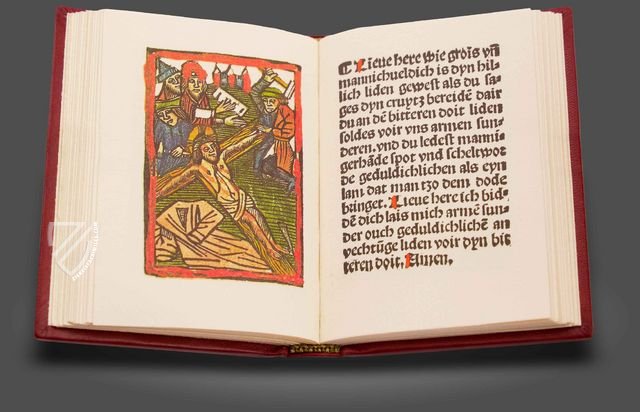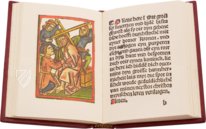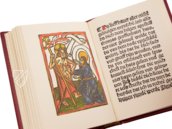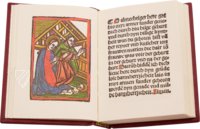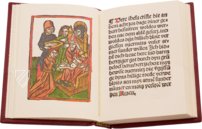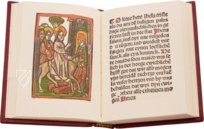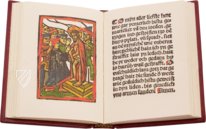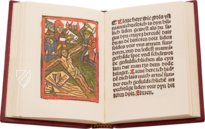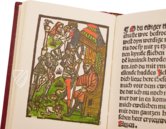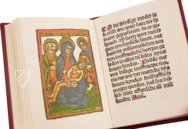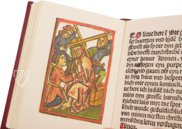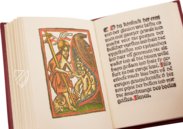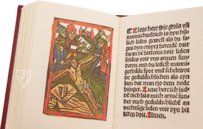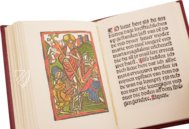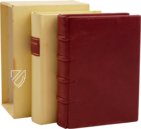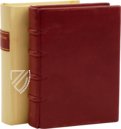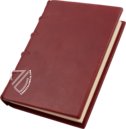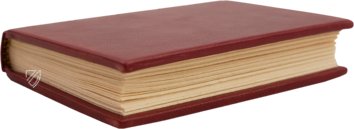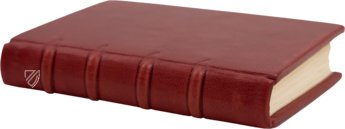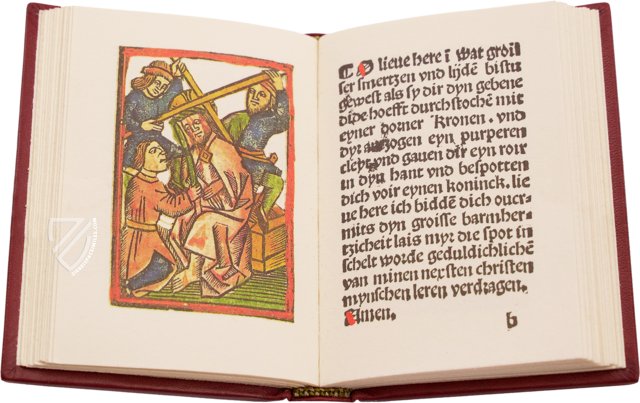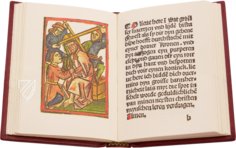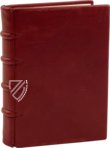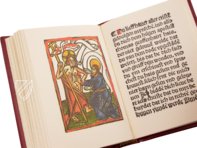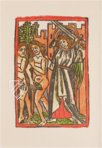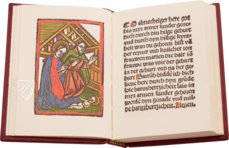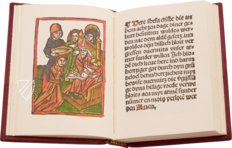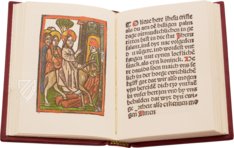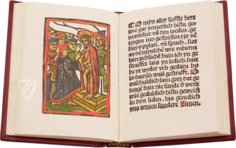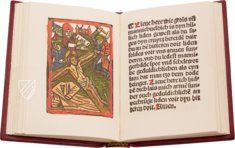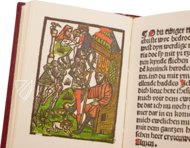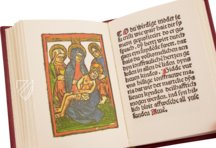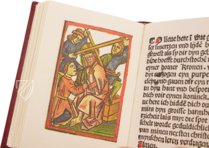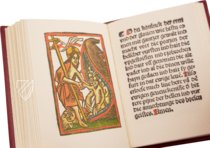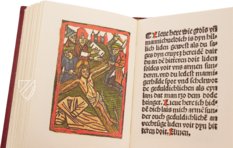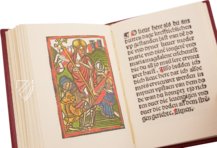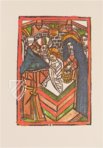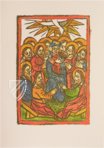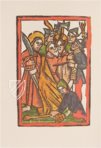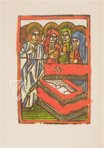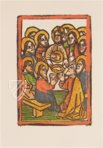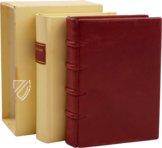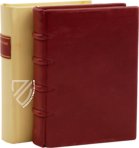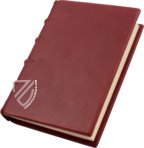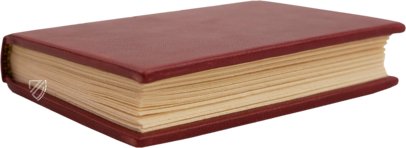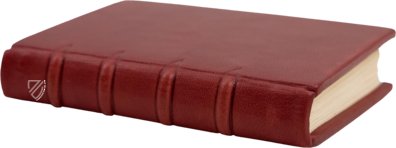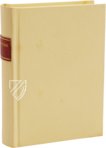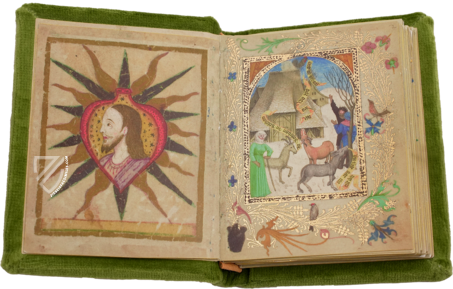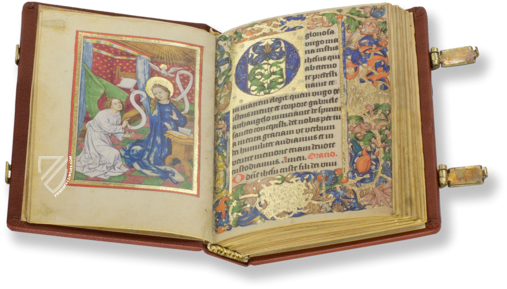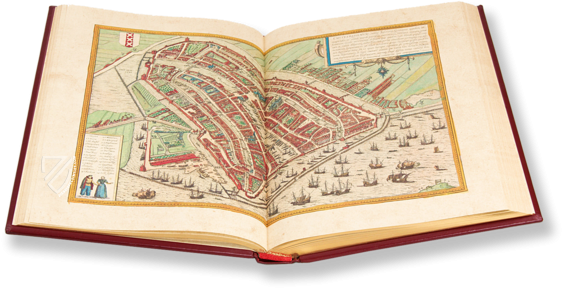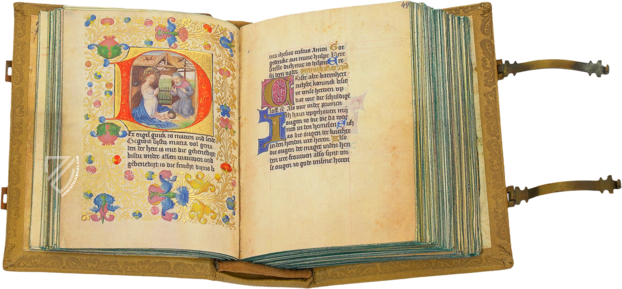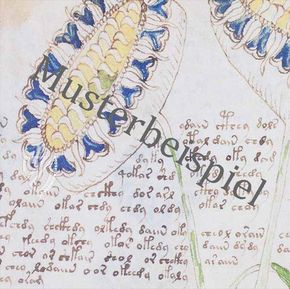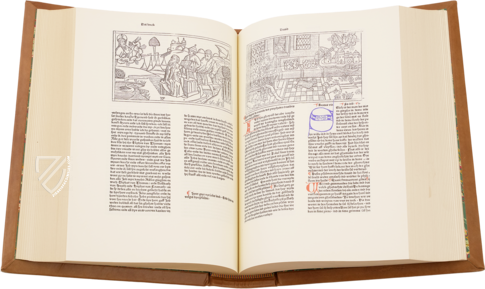Cologne Prayerbook of Johann von Landen
(1,000€ - 3,000€)
This small prayer book is a jewel of early book printing in Cologne and is written in the city’s dialect, Kölsch. Consisting of 31 leaves, the codex contains a series of prayers accompanied by colored woodcuts on the opposing pages, which constitute a complete cycle of the entire Salvation History from the Fall of Man to the Last Judgment in words and pictures. The text and imagery have been carefully designed in relation to one another, enabling the reader to deeper contemplation. Despite being undated, researchers have determined with certainty that the type used can be attributed to Johann von Landen, who enrolled at the University of Cologne in 1481. In 1503, he participated in the unsuccessful protest of Cologne’s printers against the censorship of the archbishop. It is believed that he printed this prayerbook ca. 1506–07. 68 of Landen’s prints have survived to the present, mostly religious literature intended for a lay audience, but also travelogues, schoolbooks, legal texts, a book on astronomy, and an imperial decree. One third of his texts were printed in German, which was exceptional for books produced in Cologne, of which only 4% were printed in vernacular.
Cologne Prayerbook of Johann von Landen
The so-called Cologne Prayerbook is a special treasure among the pre-Reformation German prayerbooks that have survived to the present. Measuring only 50 x 84 mm, it was obviously designed for personal use and contained 31 prayers written in Kölsch as it was spoken at the time. The codex is distinguished from earlier German prayerbooks by its picture cycle: it is designed so that each prayer text is juxtaposed by a corresponding full-page woodcut, thus making it usable for the religious edification of both the literate and illiterate. In total, there are 30 colored woodcuts from an unknown artist illustrating the simple texts. Like many incunabula, the codex has no information about when, where, and by whom it was printed. However, researchers were able to determine that the typeface used came from the printing house of Johann von Landen (1462–1522), who became a citizen of Cologne in 1497, and have determined it was printed ca. 1506–07.
A Reflection of the Zeitgeist
The Black Death not only killed millions of medieval Europeans during the mid-14th century but also shook the foundations of their beliefs. As people reexamined their souls, a new religiosity spread across Europe, which was reflected in the adoption of conservative, usually black clothing by the nobility and merchant class as though they continued to mourn the dead for generations. Pre-Reformation Germany was an extremely pious time and place marked by increased personal religious engagement by the laity. This search for faith was encouraged by contemporary authors and supported by book printers who naturally profited from the trend. As a result, there are numerous printed spiritual texts of various types that predate 1517, when Martin Luther (1483–1546) wrote his famous Ninety-Five Theses. The vast majority of these were in Latin and an astonishingly small number of private prayerbooks were printed in German, which makes this Kölsch text all the more precious.
Deceptively Simple Imagery
To the modern eye, the woodcuts illustrating this codex look simplistic and naïve but they actually make use of a rich system of imagery and symbolism that would have been self-evident to a medieval audience. For example, every gesture of the figures depicted has meaning beyond the action in the scene and refer to the broader context of salvation history. Rarely have image and text been so harmoniously designed and mutually complementary to one another. Unfortunately, this visual language is no longer part of the modern person’s vocabulary save for scholars, theologians, and the particularly devout.
Codicology
- Alternative Titles
- Kölner Gebetbuch des Johann von Landen
- Size / Format
- 64 pages / 8.4 × 6.0 cm
- Origin
- Germany
- Date
- 1506–1507
- Epochs
- Style
- Genre
- Language
- Illustrations
- 30 colored woodcuts
- Content
- Personal prayers in Cologne dialect
- Artist / School
- Printer: Johann von Landen
Cologne Prayerbook of Johann von Landen
The Arrest of Jesus
After the Last Supper, Jesus brought his disciples to the Garden of Gethsemane where the betrayer Judas kissed Jesus to identify him to a group of armed men who were lying in wait to arrest him. This scene combines the Kiss of Judas with the Arrest of Jesus by depicting the scenes simultaneously: the armed men have already appeared and laid hand on Jesus while he is still embraced by Judas. Simon Peter stands to the left with his sword drawn but has not yet wounded one of the arresting party, who are armed and dressed like contemporary foot soldiers.
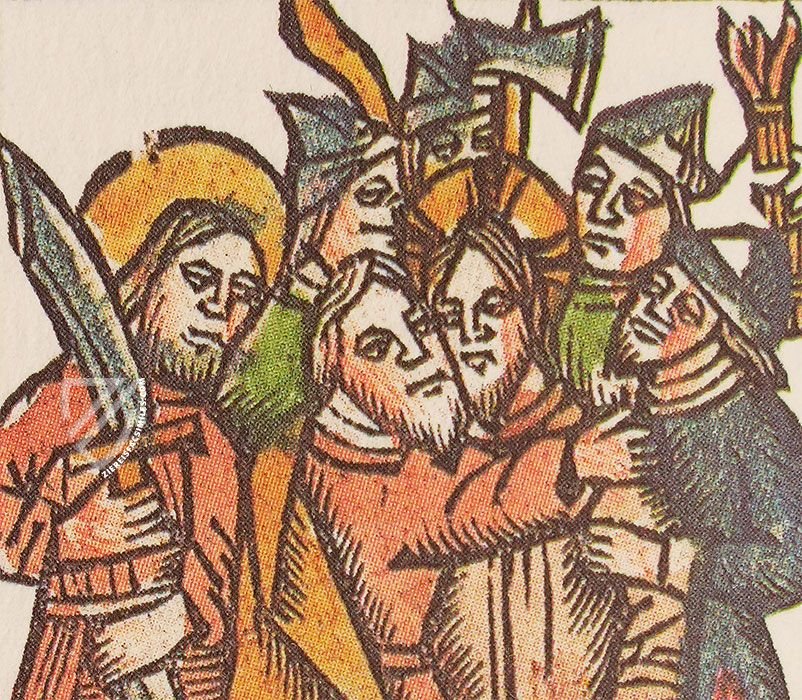
Cologne Prayerbook of Johann von Landen
The Last Supper
The designer of this woodcut has managed to fit all thirteen figures into this archetypal scene by stripping it down to only the most important elements: the benches, a table, and a plate with a fish – an early Christian symbol. While most medieval Western depictions show lamb, this woodcut follows the Byzantine model of having fish as the main meal, perhaps reflecting the influx of Greek scholars fleeing Constantinople at the time.
Jesus with his cross-halo is naturally seated in the middle with John the Evangelist, “the disciple whom Jesus loved” (Jn. 13:23), depicted asleep resting his head on the table or reclining against Jesus’ chest. The only other Apostle who is identifiable is Judas because he is the only figure in the woodcut who does not have a halo. This may be intended to represent that Satan has already entered in him.
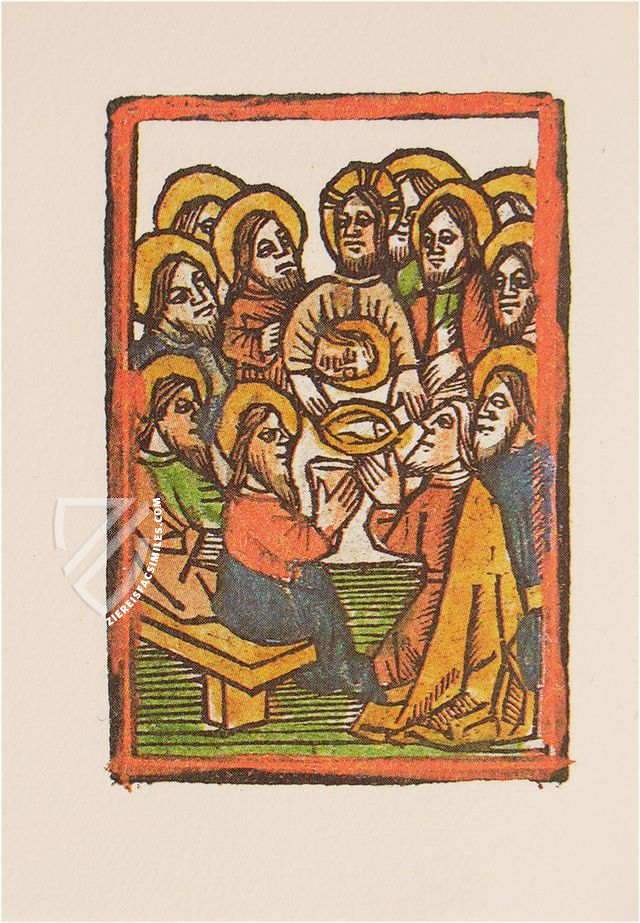
#1 Das Kölner Gebetbuch des Johann von Landen aus dem Jahre 1506/07
Language: German
With a transcription and translation by Johannes Rathofer
(1,000€ - 3,000€)
- Treatises / Secular Books
- Apocalypses / Beatus
- Astronomy / Astrology
- Bestiaries
- Bibles / Gospels
- Chronicles / History / Law
- Geography / Maps
- Saints' Lives
- Islam / Oriental
- Judaism / Hebrew
- Single Leaf Collections
- Leonardo da Vinci
- Literature / Poetry
- Liturgical Manuscripts
- Medicine / Botany / Alchemy
- Music
- Mythology / Prophecies
- Psalters
- Other Religious Books
- Games / Hunting
- Private Devotion Books
- Other Genres
- Afghanistan
- Armenia
- Austria
- Belgium
- Belize
- Bosnia and Herzegovina
- China
- Colombia
- Costa Rica
- Croatia
- Cyprus
- Czech Republic
- Denmark
- Egypt
- El Salvador
- Ethiopia
- France
- Germany
- Greece
- Guatemala
- Honduras
- Hungary
- India
- Iran
- Iraq
- Israel
- Italy
- Japan
- Jordan
- Kazakhstan
- Kyrgyzstan
- Lebanon
- Liechtenstein
- Luxembourg
- Mexico
- Morocco
- Netherlands
- Palestine
- Panama
- Peru
- Poland
- Portugal
- Romania
- Russia
- Serbia
- Spain
- Sri Lanka
- Sweden
- Switzerland
- Syria
- Tajikistan
- Turkey
- Turkmenistan
- Ukraine
- United Kingdom
- United States
- Uzbekistan
- Vatican City
- A. Oosthoek, van Holkema & Warendorf
- Aboca Museum
- Ajuntament de Valencia
- Akademie Verlag
- Akademische Druck- u. Verlagsanstalt (ADEVA)
- Aldo Ausilio Editore - Bottega d’Erasmo
- Alecto Historical Editions
- Alkuin Verlag
- Almqvist & Wiksell
- Amilcare Pizzi
- Andreas & Andreas Verlagsbuchhandlung
- Archa 90
- Archiv Verlag
- Archivi Edizioni
- Arnold Verlag
- ARS
- Ars Magna
- ArtCodex
- AyN Ediciones
- Azimuth Editions
- Badenia Verlag
- Bärenreiter-Verlag
- Belser Verlag
- Belser Verlag / WK Wertkontor
- Benziger Verlag
- Bernardinum Wydawnictwo
- BiblioGemma
- Biblioteca Apostolica Vaticana (Vaticanstadt, Vaticanstadt)
- Bibliotheca Palatina Faksimile Verlag
- Bibliotheca Rara
- Boydell & Brewer
- Bramante Edizioni
- Bredius Genootschap
- Brepols Publishers
- British Library
- C. Weckesser
- Caixa Catalunya
- Canesi
- CAPSA, Ars Scriptoria
- Caratzas Brothers, Publishers
- Carus Verlag
- Casamassima Libri
- Centrum Cartographie Verlag GmbH
- Chavane Verlag
- Christian Brandstätter Verlag
- Circulo Cientifico
- Club Bibliófilo Versol
- Club du Livre
- CM Editores
- Collegium Graphicum
- Collezione Apocrifa Da Vinci
- Comissão Nacional para as Comemorações dos Descobrimentos Portugueses
- Coron Verlag
- Corvina
- CTHS
- D. S. Brewer
- Damon
- De Agostini/UTET
- De Nederlandsche Boekhandel
- De Schutter
- Deuschle & Stemmle
- Deutscher Verlag für Kunstwissenschaft
- DIAMM
- Droz
- E. Schreiber Graphische Kunstanstalten
- Ediciones Boreal
- Ediciones Grial
- Ediclube
- Edições Inapa
- Edilan
- Editalia
- Edition Deuschle
- Edition Georg Popp
- Edition Leipzig
- Edition Libri Illustri
- Editiones Reales Sitios S. L.
- Éditions de l'Oiseau Lyre
- Editions Medicina Rara
- Editorial Casariego
- Editorial Mintzoa
- Editrice Antenore
- Editrice Velar
- Edizioni Edison
- Egeria, S.L.
- Eikon Editores
- Electa
- Emery Walker Limited
- Enciclopèdia Catalana
- Eos-Verlag
- Ephesus Publishing
- Ernst Battenberg
- Eugrammia Press
- Extraordinary Editions
- Fackelverlag
- Facsimila Art & Edition
- Facsimile Editions Ltd.
- Facsimilia Art & Edition Ebert KG
- Faksimile Verlag
- Feuermann Verlag
- Folger Shakespeare Library
- Franco Cosimo Panini Editore
- Friedrich Wittig Verlag
- Fundación Hullera Vasco-Leonesa
- G. Braziller
- Gabriele Mazzotta Editore
- Gebr. Mann Verlag
- Gesellschaft für graphische Industrie
- Getty Research Institute
- Giovanni Domenico de Rossi
- Giunti Editore
- Graffiti
- Grafica European Center of Fine Arts
- Guido Pressler
- Guillermo Blazquez
- Gustav Kiepenheuer
- H. N. Abrams
- Harrassowitz
- Harvard University Press
- Helikon
- Hendrickson Publishers
- Henning Oppermann
- Herder Verlag
- Hes & De Graaf Publishers
- Hoepli
- Holbein-Verlag
- Houghton Library
- Hugo Schmidt Verlag
- Idion Verlag
- Il Bulino, edizioni d'arte
- ILte
- Imago
- Insel Verlag
- Insel-Verlag Anton Kippenberger
- Instituto de Estudios Altoaragoneses
- Instituto Nacional de Antropología e Historia
- Introligatornia Budnik Jerzy
- Istituto dell'Enciclopedia Italiana - Treccani
- Istituto Ellenico di Studi Bizantini e Postbizantini
- Istituto Geografico De Agostini
- Istituto Poligrafico e Zecca dello Stato
- Italarte Art Establishments
- Jan Thorbecke Verlag
- Johnson Reprint Corporation
- Josef Stocker
- Josef Stocker-Schmid
- Jugoslavija
- Karl W. Hiersemann
- Kasper Straube
- Kaydeda Ediciones
- Kindler Verlag / Coron Verlag
- Kodansha International Ltd.
- Konrad Kölbl Verlag
- Kurt Wolff Verlag
- La Liberia dello Stato
- La Linea Editrice
- La Meta Editore
- Lambert Schneider
- Landeskreditbank Baden-Württemberg
- Leo S. Olschki
- Les Incunables
- Liber Artis
- Library of Congress
- Libreria Musicale Italiana
- Lichtdruck
- Lito Immagine Editore
- Lumen Artis
- Lund Humphries
- M. Moleiro Editor
- Maison des Sciences de l'homme et de la société de Poitiers
- Manuscriptum
- Martinus Nijhoff
- Maruzen-Yushodo Co. Ltd.
- MASA
- Massada Publishers
- McGraw-Hill
- Metropolitan Museum of Art
- Militos
- Millennium Liber
- Müller & Schindler
- Nahar - Stavit
- Nahar and Steimatzky
- National Library of Wales
- Neri Pozza
- Nova Charta
- Oceanum Verlag
- Odeon
- Orbis Mediaevalis
- Orbis Pictus
- Österreichische Staatsdruckerei
- Oxford University Press
- Pageant Books
- Parzellers Buchverlag
- Patrimonio Ediciones
- Pattloch Verlag
- PIAF
- Pieper Verlag
- Plon-Nourrit et cie
- Poligrafiche Bolis
- Presses Universitaires de Strasbourg
- Prestel Verlag
- Princeton University Press
- Prisma Verlag
- Priuli & Verlucca, editori
- Pro Sport Verlag
- Propyläen Verlag
- Pytheas Books
- Quaternio Verlag Luzern
- Reales Sitios
- Recht-Verlag
- Reichert Verlag
- Reichsdruckerei
- Reprint Verlag
- Riehn & Reusch
- Roberto Vattori Editore
- Rosenkilde and Bagger
- Roxburghe Club
- Salerno Editrice
- Saltellus Press
- Sandoz
- Sarajevo Svjetlost
- Schöck ArtPrint Kft.
- Schulsinger Brothers
- Scolar Press
- Scrinium
- Scripta Maneant
- Scriptorium
- Shazar
- Siloé, arte y bibliofilia
- SISMEL - Edizioni del Galluzzo
- Sociedad Mexicana de Antropología
- Société des Bibliophiles & Iconophiles de Belgique
- Soncin Publishing
- Sorli Ediciones
- Stainer and Bell
- Studer
- Styria Verlag
- Sumptibus Pragopress
- Szegedi Tudomànyegyetem
- Taberna Libraria
- Tarshish Books
- Taschen
- Tempus Libri
- Testimonio Compañía Editorial
- Thames and Hudson
- The Clear Vue Publishing Partnership Limited
- The Facsimile Codex
- The Folio Society
- The Marquess of Normanby
- The Richard III and Yorkist History Trust
- Tip.Le.Co
- TouchArt
- TREC Publishing House
- TRI Publishing Co.
- Trident Editore
- Tuliba Collection
- Typis Regiae Officinae Polygraphicae
- Union Verlag Berlin
- Universidad de Granada
- University of California Press
- University of Chicago Press
- Urs Graf
- Vallecchi
- Van Wijnen
- VCH, Acta Humaniora
- VDI Verlag
- VEB Deutscher Verlag für Musik
- Verlag Anton Pustet / Andreas Verlag
- Verlag Bibliophile Drucke Josef Stocker
- Verlag der Münchner Drucke
- Verlag für Regionalgeschichte
- Verlag Styria
- Vicent Garcia Editores
- W. Turnowski Ltd.
- W. Turnowsky
- Waanders Printers
- Wiener Mechitharisten-Congregation (Wien, Österreich)
- Wissenschaftliche Buchgesellschaft
- Wissenschaftliche Verlagsgesellschaft
- Wydawnictwo Dolnoslaskie
- Xuntanza Editorial
- Zakład Narodowy
- Zollikofer AG

